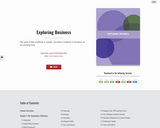
This is designed to be homework after you teach the interest formula
- Subject:
- Numbers and Operations
- Material Type:
- Activity/Lab
- Assessment
- Homework/Assignment
- Author:
- Shannay Witte
- Date Added:
- 07/14/2020

This is designed to be homework after you teach the interest formula

The author's goals in writing Exploring Business were simple: (1) introduce students to business in an exciting way and (2) provide faculty with a fully developed teaching package that allows them to do the former. Toward those ends, the following features are included in this text:1- Integrated (Optional) Nike Case Study: A Nike case study is available for instructors who wish to introduce students to business using an exciting and integrated case. Through an in-depth study of a real company, students learn about the functional areas of business and how these areas fit together. Studying a dynamic organization on a real-time basis allows students to discover the challenges that it faces, and exposes them to critical issues affecting the business, such as globalization, ethics and social responsibility, product innovation, diversity, supply chain management, and e-business.2- A Progressive (Optional) Business Plan: Having students develop a business plan in the course introduces students to the excitement and challenges of starting a business and helps them discover how the functional areas of business interact. This textbook package includes an optionalintegrated business plan project modeled after one refined by the author and her teaching team over the past ten years.3- AACSB Emphasis: The text provides end-of-chapter questions, problems, and cases that ask students to do more than regurgitate information. Most require students to gather information, assess a situation, think about it critically, and reach a conclusion. Each chapter presents ten Questions and Problems as well as five cases on areas of skill and knowledge endorsed by AACSB: Learning on the Web, Career Opportunities, The Ethics Angle, Team-Building Skills, and The Global View. More than 70% of end-of-chapter items help students build skills in areas designated as critical by AACSB, including analytical skills, ethical awareness and reasoning abilities, multicultural understanding and globalization, use of information technology, and communications and team oriented skills. Each AACSB inspired exercise is identified by an AACSB tag and a note indicating the relevant skill area.4- Author-Written Instructor Manual (IM): For the past eleven years, Karen Collins has been developing, coordinating and teaching (to over 3,500 students) an Introduction to Business course. Sections of the course have been taught by a mix of permanent faculty, graduate students, and adjuncts.

Our goal is to help you develop a framework for understanding financial, managerial, and tax reports. The course goal is divided into five subordinate challenges that can help you organize the way you learn accounting:
The record keeping and reporting challenge
The computation challenge
The judgment challenge
The usage challenge
The search challenge
The course adopts a decision-maker perspective of accounting by emphasizing the relation between accounting data and the underlying economic events generating them. Restricted to first-year Sloan MBA students.
Acknowledgements
Acknowledgment is hereby given to Professor G. Peter Wilson for his authorship of the following content in this course:
The Five Challenges (see Syllabus and Lecture 1)
"What Do Intel and Accountants Have in Common?" (see Lecture 1)
A Conceptual Framework for Financial Accounting (see Lecture 1)

This course is an introduction to the economic theories of financial crises. It focuses on amplification mechanisms that exacerbate crises, such as leverage, fire sales, bank runs, interconnections, and complexity. It also analyzes the different perspectives on the origins of crises, such as mistaken beliefs and moral hazard, and discusses the optimal regulation of the financial system. The course draws upon examples from financial crises around the world, especially the recent subprime financial crisis.
14.09 is offered during the Independent Activities Period (IAP), which is a special 4-week term at MIT that runs from the first week of January until the end of the month.